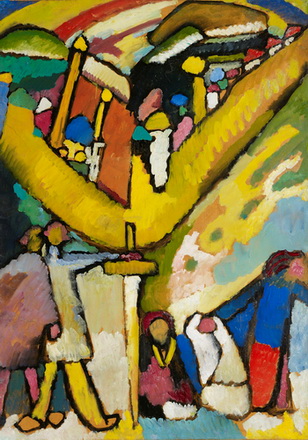Study for Improvisation No. 8

Wassily Kandinsky. (1866-1944). «Study for improvisation 8». Painted in 1909 in Murnau. Oil on cardboard laid down on canvas. 98 x 70 cm. Estimate: $20,000,000-30,000,000 © Christie's Images.
Moscow, 12.10.2012—14.10.2012
exhibition is over
Share with friends
Christie’s is pleased to show «Study for Improvisation 8» by Kandinsky at MAMM expected to fetch US$20 — 30 million, a record estimate for a work by the Russian-born artist
For the press
Widely recognized for its significance to the advancement of abstract art, the work is a fully realized study for the last of the eight numbered paintings Kandinsky created in 1909 as part of his pioneering series he called «Improvisations». Estimated at $20-30 million, the mystical scene of a conquering hero wielding a golden sword has the potential to set a new record price for any work by the artist at auction. The current record of $20.9 million was set in 1990.
«Study for Improvisation 8» was created in the same year that Kandinsky retreated to the small Bavarian town of Murnau to complete the German manuscript for his book, On the Spiritual in Art, an ambitious and impassioned call for the revitalization of art that is now recognized as the first theoretical foundation of abstract art. Concerned by what he viewed as the growing influence of the modern material world on art and emboldened by the revolutionary fervor of his compatriots in his native Russia, Kandinsky advocated for a new approach to painting inspired purely by «inner necessity» rather than external influences. With his own work, Kandinsky organized his creative output into three categories entitled «Impressions», «Improvisations», and «Compositions.» He started with the Improvisations series first, completing six numbered oil paintings and five related studies during that year, with two dozen more to follow in the years leading up to the War. Study for Improvisation 8 and its finished version in oil were the last to be completed in 1909.
Like all of the paintings and studies in the 1909 series, «Study for Improvisation 8» is richly painted in the bold, non-naturalistic color palette favored by Kandinsky and his fellow Russian-born artists of the Fauvist movement. The imagery of the painting is distinctly Russian in its inspiration as well; the walled city depicted in the upper half of the study is the old city of Kiev, with the domes and cupolas of its churches rising above the skyline. Pilgrims gather outside the city’s gates at the foreground of the painting to surround two male figures who appear to stand in defense of the city, with one planting the tip of his broadsword in the ground in a gesture of defiance or victory. Art historians suggest the swordsman may be the warrior Saint George, a favorite motif of the artist in his early career. Alternative theories suggest the two male figures are the brothers Boris and Gleb, the favorite sons of Vladimir the Great, under whose jurisdiction the city of Kiev converted from paganism to Christianity in the late 10th century.









